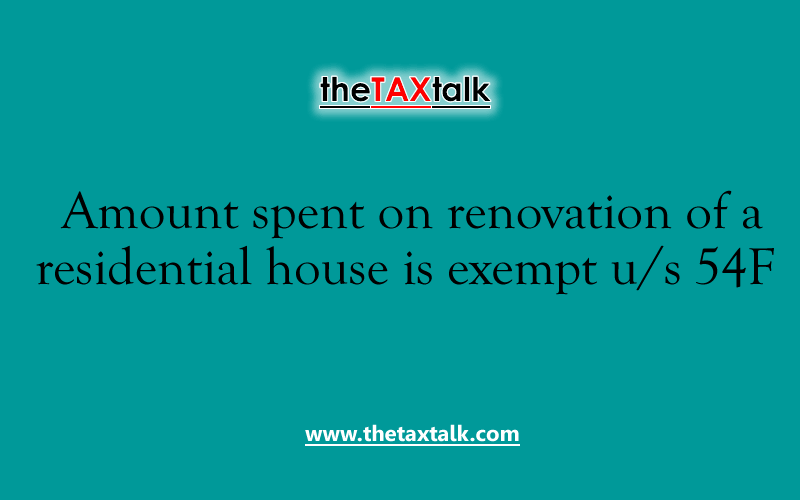![]()
Amount spent on renovation of a residential house is exempt u/s 54F
Juveria Begum Vs ITO
2224/HYD/18
297/HYD/19
298/HYD/19
340/HYD/19
The issue before the Hyderabad ITAT was whether amount spent on renovation of a residential house is allowable as exempt u/s 54F, since it amounts to construction of a residential house.
ITAT has held it as Yes & the Case was remanded back.
The short overview of the case was as under :
The assessees are family members and co-owners of a plot of land located on Banjara Hills, Hyderabad sold the same for a sum of Rs.3.5 crore vide Sale Deed.
The sale consideration was shared by the co-owners in proportion to their land holding (Rs.75.2 lakh for his share of 400 Sq. Yds. of land held by the present assessee).
The respective assessee’s claimed exemption of capital gains on purchase of a residential house collectively in the year 2006 itself to the extent it was incurred for purchase and the balance of the amount was deposited in the Capital Gains Scheme Account.
The period of three years in the assessee’s case expired in the AY.2009-10 and as per the information available on record for the AY.2006-07, the AO observed that the assessee had claimed to have utilised the amount deposited in Capital Gain Scheme Account to renovate the existing residential unit.
The AO, however, observed that the extension of the existing residential unit may not amount to investment (purchase/construction) of a new residential house.
Therefore, the AO disallowed the claim of exemption u/s. 54F.
On appeal, the CIT(A), confirmed the order of AO by holding that any investment made towards extension or modification or renovation of an existing house would not come under the purview of purchase/construction of new asset as envisaged u/s.54 or 54F of the Act.
On appeal, the Tribunal framed the issue as
Whether amount spent on renovation of a residential house is allowable as exempt u/s 54F, since it amounts to construction of a residential house.
ITAT observed as under :
++ Sec. 54F of the Act only mandates that the capital gain should be invested in ‘a residential house’ within the stipulated time by way of purchase or construction.
Thus, the amount spent on renovation of such residential house by an assessee according to his requirements is also allowable as exempt u/s.54F of the Act as it would amount to construction of a residential house.
The only other requirement is that the construction should be completed within three years from the date of transfer of the original asset.
Further, the CIT(A) also agrees that the issue is covered in favour of the assessee by the decisions of the Karnataka and Calcutta High Courts but chooses to follow the decisions against the assessee.
The Bombay High Court in the case of CIT Vs. Godavari Devi Saraf has held that – in the absence of a decision from the jurisdictional High Court, the decision of another High Court which is in favour of the assessee has to be followed.
Hence, the order of the CIT(A) is not sustainable and the assessee’s claim of exemption u/s.54F of the Act has to be examined in the light of the details submitted by the assessee and the report of the valuer submitted by the assessee in the absence of sufficient details as the construction was allegedly done in the year 2006.
Therefore, court deem it fit and proper to remit the issue back to the file of AO with a direction to allow the exemption u/s.54F of the Act in respect of the cost of the house, which is already purchased by the assessee on 29-03-2006 and also the amount spent on renovation/re-modification of the house.

